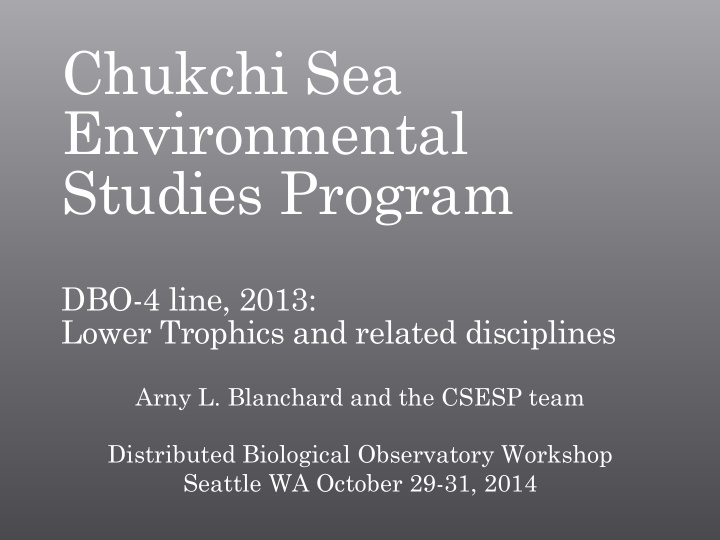



Chukchi Sea Environmental Studies Program DBO-4 line, 2013: Lower Trophics and related disciplines Arny L. Blanchard and the CSESP team Distributed Biological Observatory Workshop Seattle WA October 29-31, 2014
DISCIPLINES • Physical oceanography • Nutrients • Chemical oceanography/Acidification (Added 2010) • Zooplankton (microplankton in 2012) • Benthic macrofauna • Marine mammal observations • Seabird observations • MM acoustics (moorings nearby)
CSESP STUDY AREA 2013 DF007 DF006 • DBO-4 line crosses HC014 strong depth and SF014 SF009 physical gradients. BF021 BF017 BF013 • Sampled 2012 and BF009 BF005 2013. DF005 DF004 DF003 DF002 DF001
DBO-4 Line Physical Conditions • Coarser sediments in more dynamic, shallower water. Nearshore Offshore
DBO-4 Line Physical Conditions (9/25/2013-10/6/2013) MW BSW MW ACW BSW WW ACW = Alaska Coastal Water, BSW = Bering Sea Water, MW = melt water, WW = winter water At seafloor: Colder & more saline waters offshore Warmer, fresher waters nearshore
DBO-4 Line Benthic Biomass • Strong spatial gradient: Low nearshore (DF001) and high offshore. Bivalves with high biomass throughout.
DBO-4 Line Benthic Density • Strong spatial gradient: Low density nearshore (DF001) and high offshore. High amphipod density inshore and bivalve density offshore.
Physical/Biological interactions • Average benthic density of 9 repeatedly sampled stations in the CSESP study area vs. the Arctic Oscillation index (Nov-March). • Average richness vs. winter AO. From 2008 to 2012: r = 0.85 for density and r = 0.78 for richness From 2008 to2013: r = 0.15 and r = -0.05. Association between benthic structure and water circulation evident elsewhere in NP.
DBO-4 Line Seabirds 2013 King Eider Common Eider* Long-tailed Duck Loon Common Murre Northern Fulmar Thick-billed Murre Short-tailed Shearwater Black Guillemot Phalaropes Least Auklet Black-legged Kittiwake Crested Auklet* Ross’s Gull Thayer’s Gull Glaucous Gull* * = most abundant. Benthic-feeding birds most abundant nearshore and absent >100 km • offshore. Surface-feeding birds occurred along most of the line. • Diving birds more abundant offshore than nearshore . •
DBO-4 Line Marine Mammals 2013
Summary • As expected, distributions of benthic fauna, seabirds, and marine mammals reflect physical conditions (conclusions from CSESP & DBO). • Benthic fauna reflect physical conditions. Disturbance-tolerant isopods and nematodes predominate in shallow waters. Effect of expected increased wave energy, disturbance, etc. in shallow water (15m) created strongest environmental/spatial gradient. Major range extensions! Bivalves and polychaetes offshore. Same patterns for benthic in 2012, but less visible due to fewer sampling locations.
CSESP 2014 • Sampling extensively nearshore.
Seeds for thought: Focusing on the long-term Design for long-term analyses Port Valdez benthic density 1971-2007. Now a 40+ year database! Inferences from this data for any 5-year “window” will be misleading.
Seeds for thought: Focusing on the long-term Making conclusions with limited data Gaining 10 to 20% new species per year. < 50% species accounted for? After 10 years, <75% species accounted for. Don’t be in a hurry to publish. Account for uncertainties.
Seeds for thought: Focusing on the long-term Standardize methods • Expecting multiple investigators to sample same locations within a year, many players. • Incompatible data can result from: Changing equipment. Changing labs. Etc. • Develop standardized methods, taxon lists, etc. to increase data usability. e.g., Blanchard lab working on reconciliation of macrofaunal taxonomy across whole of Alaska’s coastal waters.
Find out more about the Chukchi Sea Environmental Studies Program (CSESP) at: www.chukchiscience.com
Recommend
More recommend